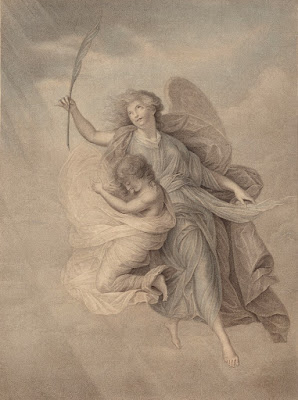Anne
Claude Philippe de Tubières, Comte de Caylus (aka Caylus; Anne
Claude de Caylus; Anne Claude de Pestels) (1692–1765)
“Le Saint Esprit descendant sur les Apôtres” (The Holy Spirit
descending on the Apostles), c1729–64, from the series, “Recueil d'estampes
d'après les plus beaux tableaux et d'après les plus beaux desseins qui sont en
France” (Collection of prints from the most beautiful paintings and from the
most beautiful designs that are in France”) (aka “Recueil Crozat”; “Cabomet
Croza”), after the drawing by Giovanni
Battista Lenardi (1656–1704).
Etching and aquatint imitating a chiaroscuro woodcut, printed in
two shades of green, on laid paper, trimmed unevenly and well within the image
borderline with substantial loss to the upper section of the print (see the
whole composition at Gallica: http://gallica.bnf.fr/ark:/12148/btv1b6956138w.item
) and backed with a support sheet.
Size: (unevenly trimmed sheet) 27.3 x 23 cm
Condition: crisp, well-inked and well-printed impression, trimmed
within the image borderline with significant losses on all sides, otherwise the
sheet is in excellent condition for its age (i.e. there are no tears, holes,
folds, abrasions, stains or foxing) and backed with a support sheet of archival
(millennium quality) washi paper.
I am selling this FRAGMENT of a larger print for study purposes only,
for AU$104 (currently US$78.60/EUR67.37/GBP59.10 at the time of posting this
print) including postage and handling to anywhere in the world.
If you are interested in purchasing this FRAGMENT of a historically
important print (see previous post), please contact me
(oz_jim@printsandprinciples.com) and I will send you a PayPal invoice to make
the payment easy.
This print has been sold
At first glance, this fragment of a print might seem to be a green
version of the brown print shown in the previous post, but this is only partly
true. Certainly, the composition is the same, but the portrayed figures in this
fragment reveal a stage of refinement that is a step beyond the treatment of
the same figures in the brown version. Essentially this green fragment is from
a late state in the evolution of the print and the brown version of the
previous post is from an early state. To my eyes the subtle changes made to the
image from the early to the late state—and there are MANY changes—is like a
psychological portrait of comte de Caylus in terms of revealing his aesthetic
sensitivities.



















































